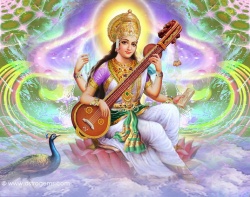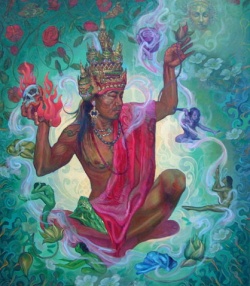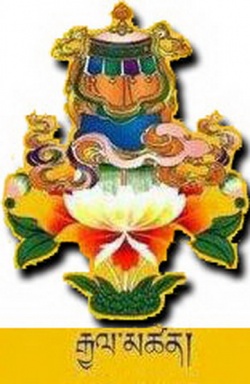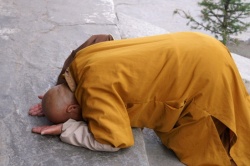The Genesis of Mental Afflictions
The Genesis of Mental Afflictions
By Indrajala (Jeffrey Kotyk)
The term kleśa in English is often translated as “affliction” or “defilement”. These are normally suitable, but a clear definition of the term is best understood, as it ties in not just with discerning inner mental processes, but also the unfolding of karma and its effects.
Monier-Williams Sanskrit-English Dictionary defines kleśa as “pain, affliction, distress, pain from disease, anguish”.
The Mahāprājñāpāramitā Upadeśa by Nāgārjuna defines it as follows:
- 《大智度論》卷27〈1 序品〉:「煩惱」名,略說則三毒,廣說則三界九十八使,是名「煩惱」。」(CBETA, T25, no. 1509, p. 260, c1-2)
- The term kleśa-s: in the abbreviated explanation they are the three poisons. In the extended explanation they are the ninety-eight latent afflictions (anuśaya) of the three realms.[1]
The three poisons here are craving (rāga), anger (dveṣa) and nescience (moha). These condition and direct the mind towards various actions.
An important related term is the vāsanā-kleśa, which is subsequently defined in said text as follows.
- 「煩惱習」名煩惱殘氣,若身業、口業不隨智慧,似從煩惱起;不知他心者,見其所起,生不淨心,是非實煩惱,久習煩惱故,起如是業。譬如久鎖腳人,卒得解脫,行時雖無有鎖,猶有習在。
- The term vāsanā-kleśa-s: residue of the kleśa-s, which seem to arise from the kleśa-s when bodily and verbal karma do not comply with wisdom. Not knowing the mind of another and witnessing what arises with them, there is produced an impure mind (?). This is not an actual kleśa. It is due to long habituated kleśa-s that karma such as this is brought about. It is like someone who has long been fettered and is suddenly liberated. Although when they walk there are no fetters, the habituation to them is still present.
The traces of afflictions or vāsanā-kleśa affect even noble (ārya) beings such as arhats, which explains some of the otherwise inexplicable behaviors of certain notable figures:
- 《大智度論》卷27〈1 序品〉:「如是諸餘賢聖雖能斷煩惱,不能斷習。如難陀婬欲習故,雖得阿羅漢道,於男女大眾中坐,眼先視女眾,而與言語說法。」(CBETA, T25, no. 1509, p. 260, c9-12)
- As such although the other worthy and noble beings are able to sever kleśa-s, they cannot sever the vāsanā-s, like Nanda who due to his habituated sexual desire would sit amongst the great male and female assemblies with his eyes first looking at the female assembly though he had attained arhatship, yet still he would speak to them and teach the Dharma.
The idea here is that Nanda was an arhat and thus was no longer subject to the kleśa of desire (kāma), yet still displayed a subtle inclination towards females. This is explained as merely the residual force of past afflictions.
Based on the general theory of the Satyasiddhi Śāstra, kleśa-s arise due to the “grasping at signs” (nimitta-grāha), which in turn leads to karma and subsequent saṃsāric existence.[2] The term nimitta-grāha is perhaps understood as reification, where both internal mental and external physical phenomena are cognized and subsequently affirmed as existent thus generating an object to which action can be directed. Consequently, the process of saṃsāra can be halted by ending nimitta-grāha. This is what the realization of the emptiness of self would entail liberation.
This differs from the theory presented by Vasubandhu in his Abhidharmakośa-bhāṣya. For Vasubandhu the kleśa-s exist based on three factors:
- For example, lust arises (1) when the anuśaya of lust is non-abandoned -- not completely-known (aparijñāta) -- its opposition not having arisen;
(2) when the dharmas which provoke the manifestation of lust, namely visible things, etc., are found in the field of experience (abhāsagata=viṣayarupatā-āpanna) and (3) when there is erroneous judgment.
- The anuśaya is the cause; the dharmas are its object; and incorrect judgment is its immediate preparation: three distinct forces.
Vasubandhu here is asserting that kleśa-s arise as a result of latent or “sleeping” kleśa-s, otherwise called anuśaya. At an earlier level of the causal production of one's reality the anuśaya enable action which leads to rebirth (punarbhava):
- We said that the world, in all its variety, arises from action. Now it is by reason of the anuśayas, or latent defilements, that actions accumulate; in the absence of the anuśayas, actions are not capable of producing a new existence. Consequently,
The text initially defines six anuśayas: attachment, anger, pride, ignorance, false views and doubt (there are longer lists as well). Attachment is divided into attachment to pleasure or sensual desire and attachment to existence. The latter is notable because the practitioner must forsake not just pleasures, but also the desire to exist itself.
The term anuśaya should be further clarified. For the Sautrāntikas, whose ideas Vasubandhu is employing here, the anuśaya is the seed of the kleśa, or a dormant kleśa. Vasubandhu cites their theory as follows:
- What is called anuśaya is the kleśa itself in a state of sleep, whereas the paryavasthāna is the kleśa in an awakened state. The sleeping kleśa is the non-manifested kleśa, in the state of being a seed; the awakened kleśa is the manifested kleśa, the kleśa in action. And by "seed" one should understand a certain capacity to produce the kleśa, a power belonging to the person engendered by the previous kleśa.[5]
This is in contrast to the Sarvāstivādins where kleśa is the equivalent of anuśaya. In this context this differs from a vāsanā-kleśa in that while an anuśaya is potent and able to ripen into an active kleśa, the vāsanā-kleśa is a trace of a formerly existent kleśa. As similes we might think of anuśaya-s as fertile seed in soil (the mind), kleśa-s as live plants and vāsanā-kleśa-s as burnt plants, which although destroyed still affect to some small degree the soil in which they exist (i.e., the traces of affliction within the mind).
The kleśa-s do not directly cause karma, but they are a necessary condition and orient the quality and direction an action will take. It is volition that directly causes karma. The Buddha in the Aṅguttaranikāya states,
- "Oh monks, I say that action is volition; after having willed it, one accomplishes action by means of the body, the voice and the mind."[6]
That is to say action (karma) is volition (cetanā) from which a process of activity is carried out via body, speech and mind. Volition is oriented based on inner experiences. The kleśa-s do not produce karma, only facilitate it.
Vasubandhu above states that “it is by reason of the anuśayas, or latent defilements, that actions accumulate”. Here in Sanskrit upacayaṃ gacchanti can mean "to accumulate" or “to promote or advance the prosperity of, help, assist”.
He further states that “in the absence of the anuśayas, actions are not capable of producing a new existence”. In the absence of latent and potent afflictions such as pride and attachment there is no possibility for rebirth to occur.
As noted above, the arhat may be subject to the traces of afflictions or vāsanā-kleśa-s, but not any anuśaya-s. If they did possess any anuśaya-s, then rebirth could occur, but an arhat is not subject to rebirth, so we thus know an arhat is free of anuśaya-s. Their continued existence prior to physical death is described as “nirvāṇa with remainder” (sopadhiśeṣa-nirvāṇa), which means the past karma which resulted in their final birth is still active until physical death, whereupon they attain “nirvāṇa without remainder” (nirupadhiśeṣa-nirvāṇa).
Vasubandhu goes on to explain at length the process of abandoning the anuśaya-s. There are two inclusive paths: “seeing” and meditation (bhāvanā). "Meditation" here consists of repeated contemplation. Needless to say, before this is possible the practitioner needs to cultivate good qualities, mindfulness, mental stamina gained through sustained concentration on the breath and contemplation of disgust for saṃsāra. Disgust is what enables the first dhyāna, which means the practitioner must become thoroughly dissatisfied with all aspects of the kāma-dhātu or desire realm (that would includes sensual pleasures like sex, food and music) as a prerequisite for liberation (that entails celibacy as a requirement for even the first result of stream-entry). The whole process ends with all afflictions destroyed and the attainment of arhatship.
Taking into consideration everything above, the key terms from Vasubandhu can be summarized as follows:
- anuśaya – The “sleeping” or inactive mental affliction such as attachment, anger, pride, ignorance, false views and doubt.
- kleśa – The “awake” or active mental affliction directing karma.
- vāsanā-kleśa – The trace or habituation imprinted in the mind that still directs a small degree of action.
Finally, alternative theories on liberation, such as those from Mahāyāna advocates and some others, are generally predicated on the realization of the emptiness of self and/or phenomena (which consequently halts and eliminates afflictions) rather than primarily eliminating afflictions as Vasubandhu's model requires. Vasubandhu includes erroneous views of self as only one type of view that must be remedied for the process of liberation to proceed. He also has a different perspective on the qualities of dharma-s or phenomena.
In the long-term development of Buddhism(s), the alternative theories of liberation via the realization of emptiness of self and/or phenomena meant that this could be seen as more important and moreover the optimal way of attaining liberation rather than living a life of renunciation and self-restraint. This presumably enabled the lay movement of married clergy in India to justify its existence to some degree in the face of criticism from figures not unlike Vasubandhu who would have insisted upon celibacy and restraint as prerequisites for liberation. In other words, it is grasping and attachment that need to be remedied as the primary task, not the successive elimination of afflictions.
Nevertheless, as Nāgārjuna notes in his Letter to a Friend, wisdom is only attained via the mental stamina gained through dhyāna. While not expressly stated, the attainment of even the first dhyāna generally requires renunciation of sensual desires. It logically follows that realization of emptiness (wisdom) requires suitable mental stamina that is only gained through determined renunciation and active abandonment of sensual desires and pleasures.
All things considered there were many opinions on the genesis of afflictions and their remedy. Vasubandhu cites some alternative contemporary opinions, all of which are worth considering. The discussions on this subject are rich and perhaps aids the Buddhist practitioner to discern for themselves how and why these mental events arise and affect our decision making processes and actions. I think it best to take these models for liberation as general guidelines rather than absolute sequences that must be followed in the specified order.
Footnotes
- ↑ This refers to an Abhidharmaika classification. Ten anuśaya-s comprise thirty-six anuśayas in the kāmadhātu, thirty-one anuśaya-s in rūpadhātu, and thirty-one anuśayas in the ārūpyadhātu: in all ninety-eight anuśaya-s.
- ↑ 《中觀論疏》卷4〈4 五陰品〉:「依成實人答者。由取相煩惱感得生死中一切無常法也。」(CBETA, T42, no. 1824, p. 69, a17-19)
- ↑ Abhidharma-kośa-bhāṣya. Trans. Louis De La Vallee Poussin. English trans. Leo M. Pruden. Berkeley: Asian Humanities Press, 1991. See v. 3, p. 828.
- ↑ Ibid., 767-768.
- ↑ Ibid., 770.
- ↑ Cetanāhaṁ bhikkhave kammaṁ vadāmi, cetayitvā kammaṁ karoti kāyena vācāya manasā. Translation from Karmasiddhi Prakarana The Treatise on Action, 15.





